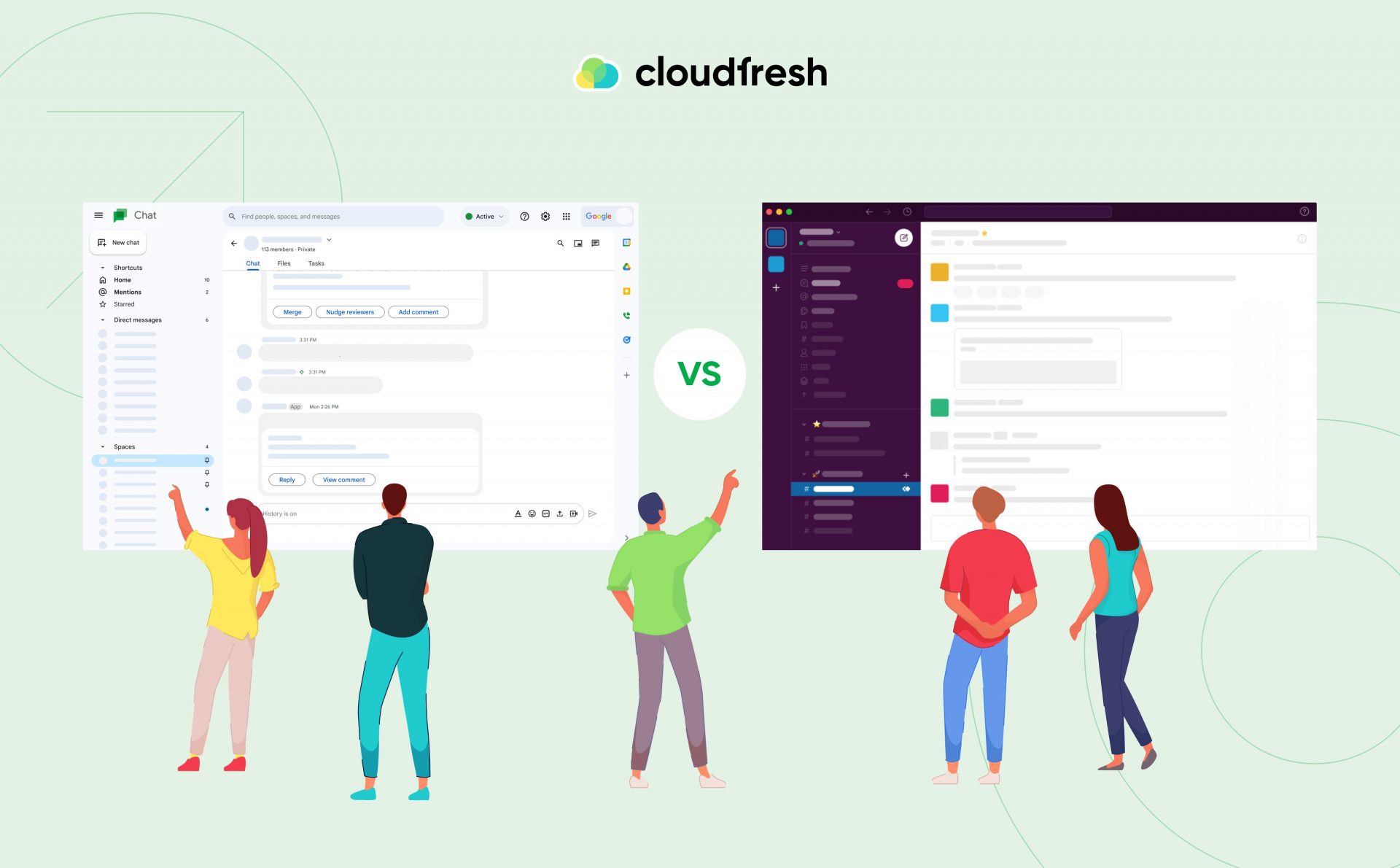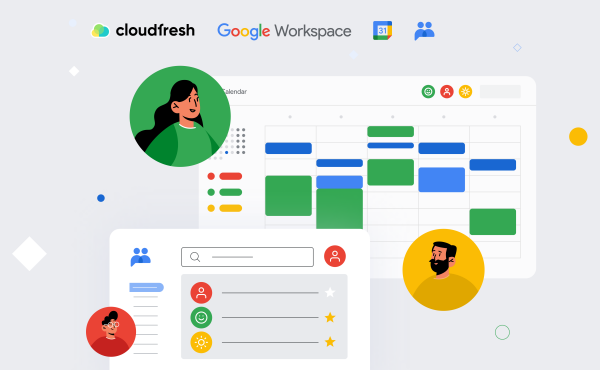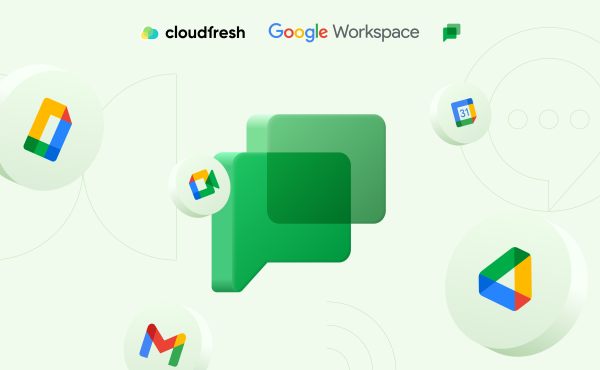7 Ways to Access Google Meet
The Battle of Workplace Communication Giants: Google Chat vs Slack

In a world reshaped by remote and in-office meetings, messaging and video conferencing have become our lifelines. As businesses navigate from Slack to Google Chat, part of the rich Google Workspace, teams are on an adventure to unlock the potential of this comprehensive communication tool.
In this blog, we reveal five Google Chat features that promise to enhance productivity and collaboration, treasures once familiar to Slack users. With enthusiasm and a spirit of care, let’s dive into how Google Chat can brighten our journey toward more connected and effective teamwork.
Does Google Workspace Offer an Alternative to Slack?
Indeed, Google Workspace (formerly G Suite) has embraced the world of workplace communication with its own vibrant Google alternative to Slack, Google Chat. This app sparkles with features we adore, from direct messaging and group chats to file sharing and video meetings via Google Meet.
What is Google Chat?
Google Chat is a straightforward communication tool that streamlines collaboration within teams and organizations. Part of the Google Workspace family, it offers seamless integration with other Google apps like Gmail, Drive, and Docs – making it a natural fit if you’re already embedded in that ecosystem. With a user-friendly interface focused on direct messaging and group conversations, Google Chat aims to simplify how you connect and work together.
What is Slack?
Slack is another team communication platform focused on messaging and file sharing. As a Google Chat alternative, it integrates with various apps and services, allowing teams to customize their workspace. While capable, Slack is a third-party tool that operates separately from Google’s native productivity suite. For teams already using Google Workspace apps, Google Chat provides a seamless, integrated experience by keeping all your collaboration within the Google ecosystem.
Google Chat Overview
Google Chat is a team messaging and collaboration app that’s part of Google Workspace. It helps teams stay connected and get work done more efficiently by combining messaging, file sharing, task management, and virtual meetings into one seamless experience. What is Google Chat used for? Here are some key highlights about Google Chat:
- Deep Integration with Google Workspace
- Seamlessly works with Gmail, Drive, Docs, Sheets, Slides and more
- Share and collaborate on Google files directly in chat
- Start or join Google Meet video calls with one click
- Streamlined Communication
- Direct messaging and group conversations
- Threaded conversations keep chats organized
- Quickly @mention teammates to grab their attention
- Customizable notification settings
- Powerful Search and Filtering
- Google’s powerful search capabilities built-in
- Search across messages, files, people, and more
- Advanced filters to find exactly what you need
- Organizational Structure
- Create rooms/spaces for teams, projects, topics
- Control access and permissions for each room
- Real-time File Collaboration
- Work together on documents, spreadsheets, slides
- See changes as they happen with version control
- Work Tracking and Productivity
- Create and assign tasks with due dates
- Bot integrations for workflows, approvals, notifications
With Google Chat’s straightforward interface and deep Workspace integration, teams can reduce app switching and work seamlessly across communication and collaboration workflows. The robust search, organized spaces, and real-time file collaboration empower teams to get more done together efficiently.

Slack Overview
Slack is a functional tool for team communication and collaboration, centralizing workplace conversations, file management, and project tracking. It coordinates teams, supports discussions, and aligns everyone with organizational goals. Key features that define Slack include:
- Simple Integrations Choices:
- Integrates with numerous third-party apps, allowing teams to bring their work together.
- Slack’s adaptability means users can tailor their experience to the tools they already use and love.
- Basic Communication Options:
- It features direct messaging and channels for group discussions, making staying connected easily with team members.
- Offers threaded messages to keep conversations organized and allows for focused discussions within the broader Slack chat.
- Customizable Notifications:
- Users can adjust their notification preferences to stay informed without being overwhelmed.
- The ability to search for conversations, files, and mentions makes finding information straightforward.
- Standard Workspace Structuring:
- Slack allows for creating channels for projects, teams, or topics, helping maintain order and accessibility.
- It supports file sharing and collaboration, although it relies on document editing and real-time co-authoring integrations.
- Productivity and Workflow Enhancements:
- Slack’s workflow builder and app integrations automate tasks and streamline processes.
- While Slack facilitates task tracking and project management, additional integrations are often required to realize these capabilities fully.
For teams already utilizing Google Workspace, Google Chat’s seamless integration across email, document editing, and video calls within the Google ecosystem presents a significant advantage over Slack, reducing app-switching and streamlining workflows. While Slack is robust with its integrations and customization, Google Chat offers a more cohesive and efficient experience for those embedded in the Google environment.
Comparing Google Chat vs Slack: A Look at Features
| Feature | Google Chat | Slack |
| Integrations | Deep integration with Google Workspace apps like Gmail, Drive, Docs, Sheets, etc. Seamless collaboration within Google's ecosystem | It integrates with numerous third-party apps and services but is separate from Google's native productivity suite. |
| User Interface | Clear, intuitive interface consistent with Google's design language. Familiar experience with Google Workspace users. | Customizable interface with various view options, emojis, and themes. Can feel cluttered for some users. |
| File Sharing | Natively supports sharing Google Drive files and links. Version control via Google Docs integration. | Allows uploading files from desktop or linked cloud storage. Limited version control capabilities. |
| Search | Powerful search capabilities leveraging Google's search technology. Can search messages, files, people, etc. | Text-based search within channels and conversations. Limited search filters and capabilities. |
| Pricing | Part of Google Workspace subscription plans. It is more cost-effective for teams using other Google apps. | A freemium model with paid plans based on several users. Can become costly for larger teams. |
| Security & Compliance | Inherits Google Workspace's robust security, data protection, and compliance standards (HIPAA, GDPR, etc.) | Meets standard security and compliance regulations but is separate from Google's security model. |
| Virtual Meetings | Integrated with Google Meet for video conferencing directly from Chat. | Integrates with third-party video conferencing tools like Zoom, Microsoft Teams, etc. |
Slack vs Google Chat: An In-depth Review
Regarding team communication and collaboration tools, Google Chat and Slack are two of the most popular options in the market. While both platforms aim to streamline messaging, file sharing, and project management, Google Chat stands out with its deep integration within the Google Workspace ecosystem, providing a seamless and cost-effective solution for teams already using Google’s productivity apps.
1. Seamless Integration with Google Workspace
One of the most significant advantages of Google Chat is its native integration with other Google Workspace applications, including Gmail, Drive, Docs, Sheets, and more. This integration allows for a smooth collaboration experience, enabling users to share files, edit documents, and coordinate tasks without leaving the chat interface. For teams heavily reliant on Google’s suite of tools, this level of integration ensures a cohesive and efficient workflow, eliminating the need to switch between multiple applications or platforms.
2. Familiar User Interface
Google Chat’s user interface is designed to be consistent with other Google Workspace apps’ clean, intuitive aesthetic. This familiarity makes the transition to Google Chat seamless for existing Google users, reducing the learning curve and minimizing disruption to established work routines. The interface prioritizes clarity and simplicity, ensuring that conversations and file sharing remain organized and easily accessible.
3. Powerful Search Capabilities
Leveraging Google’s renowned search technology, Google Chat offers robust search capabilities beyond text messages. Users can search for specific files, people, or conversations across their entire chat history, making it easier to find and retrieve relevant information quickly. This search functionality is particularly valuable for teams handling large volumes of communication and data, ensuring that important information remains easily accessible.
4. Cost-Effectiveness for Google Workspace Users
Google Chat is a cost-effective solution for teams already subscribing to Google Workspace plans. Unlike Slack, which requires separate subscription fees based on the number of users, Google Chat is included as part of the Google Workspace subscription. This cost-effectiveness can be particularly beneficial for larger teams or organizations, making Google Chat a more economical choice, especially considering the additional value the integrated Google Workspace tools provide.
5. Robust Security and Compliance
As part of the Google Workspace ecosystem, Google Chat inherits the robust security, data protection, and compliance standards that Google is renowned for. This includes adherence to regulations such as HIPAA, GDPR, and industry-specific compliance requirements. With Google’s commitment to data security and privacy, teams can have confidence in protecting their sensitive information and communication.
While Slack offers a range of features and customization options, Google Chat’s deep integration with Google Workspace, intuitive user experience, powerful search capabilities, cost-effectiveness, and robust security make this Slack alternative a compelling choice for teams already invested in Google’s productivity ecosystem. By leveraging the synergies between Google’s tools, teams can streamline their collaboration efforts, enhance productivity, and maintain a cohesive and secure digital workspace.

5 Key Google Chat Tools Enhancing Productivity for Former Slack Users
1. Threaded Discussions in Spaces
Google Chat introduces “Spaces” for group messaging, a departure from Slack’s “Channels.” Spaces focus on threaded conversations as the default, promoting more organized and focused discussions and minimizing confusion. Members can respond to threads or start new ones, enhancing communication clarity. Like Slack, you can create multiple Spaces with the same members, assign tasks, and share files, with added features like Discoverable Spaces for easier organizational communication and a consistent message history policy.
2. Direct Messages in Group Conversation
Group Conversations in Google Chat serve the purpose of Slack’s Direct Messages, designed for quick, direct communication among individuals or small groups. These conversations support leaving and rejoining, notifications for every message, and creating multiple discussions with the same members. However, unlike Spaces, Group Conversations don’t have task management features and have different message history settings based on the organization’s preferences.
3. Integrated Chat and Meet
Google Chat offers seamless integration with Google Meet, providing a robust platform for video conferencing with advanced features like real-time captioning and Companion Mode for sharing from a second screen. This integration allows for a more cohesive workflow between chat and video meetings than Slack’s built-in video calls, allowing users to easily create, schedule, join, share, and manage meetings directly for the Chat.
4. Deep Integration with Google Workspace
Google Chat is tightly integrated within the Google ecosystem, offering direct access from Gmail and easily including Google Workspace tools in conversations. This deep integration simplifies collaboration and allows for side-by-side document editing and initiating Google Meet calls directly from chat discussions.
5. Unlimited Message History
Unlike Slack’s freemium version, which limits message history, Google Chat provides unlimited message history, aligning better with organizations’ needs for documentation and compliance without extra costs. Message history settings are customizable to suit different organizational needs.
Final thoughts
For the best team collaboration, Google Chat shines as the smart and simple choice, especially if you’re already using Google’s amazing productivity tools. Chat integrates seamlessly, providing a familiar, user-friendly experience that fits right into your existing workflow.
Plus, with powerful search and robust security inherited from Google, you get an energetic assistant that’s caring about your team’s effectiveness and data protection. While Slack is capable, for Google Workspace users, Chat stands out as the respectful, cost-effective option that harmonizes perfectly with Google’s ecosystem.
Kick off your Google Chat experience with Cloudfresh today!
Cloudfresh is here to make Google Chat and Workspace easy for you. As a certified Google Cloud Partner, we provide solutions perfect for any business size, helping with everything from setup to training.
Looking to improve Google Chat, share Google accounts, or organize your Google Calendar better? Drop by our website for a free consultation. Our team is ready to help you get the most out of Google Workspace.
Let’s work better together with Google Chat and Workspace. Thinking of taking the next step? Our certified consultants are just a message away.












